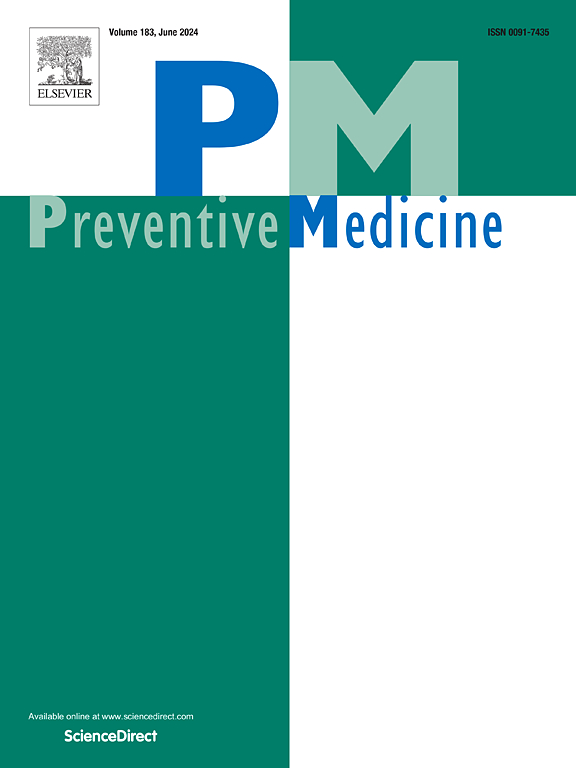美国青少年的粮食不安全和药物使用情况。
IF 4.3
2区 医学
Q1 MEDICINE, GENERAL & INTERNAL
引用次数: 0
摘要
目的:本研究的目的是探讨美国 18-25 岁青壮年中食物不安全与药物使用之间的关系:2022 年 1 月至 4 月间,1024 名年轻成年人(50.2% 为女性;62% 为非白人;平均年龄 = 21.7[SD = 2.26])完成了一项横断面在线调查。在控制社会人口和经济因素、心理健康和歧视经历的情况下,使用逻辑回归分析来研究食物无保障与当前吸烟、使用电子尼古丁输送系统(ENDS)、吸食大麻、饮酒和酗酒之间的关系:近 70% 的参与者表示在过去一年中粮食无保障。使用药物的情况也很普遍:45.9%的参与者表示目前使用香烟,50.9%使用ENDS,57%使用大麻,65.9%饮酒,50.4%在过去两周内酗酒。食物无保障与吸烟(OR = 2.49,95 % CI = [1.77,3.50])、使用 ENDS(OR = 2.18,95 % CI = [1.58,3.01])、吸食大麻(OR = 1.73,95 % CI = [1.26,2.37])、饮酒(OR = 1.60,95 % CI = [1.16,2.19])和暴饮暴食(OR = 1.98,95 % CI = [1.44,2.72]):结论:食物不安全可能是青少年使用药物的一个重要指标。从业人员应考虑筛查食物不安全状况,提供有关食物获取的信息,并制定干预措施,以解决他们所服务的青壮年中存在的食物不安全问题。未来的研究应该对这些关联进行前瞻性研究,以更好地了解食物不安全如何导致药物使用的开始和/或升级。本文章由计算机程序翻译,如有差异,请以英文原文为准。
Food insecurity and substance use among young adults in the United States
Purpose
The purpose of this study was to examine the association between food insecurity and substance use among young adults aged 18–25 in the U.S.
Methods
A cross-sectional online survey was completed by a diverse sample of 1024 young adults (50.2 % female; 62 % non-white; m age = 21.7[SD = 2.26]) between January–April 2022. Logistic regression analyses were used to examine the association between food insecurity and current cigarette use, Electronic Nicotine Delivery System (ENDS) use, cannabis use, alcohol use, and binge drinking controlling for socio-demographic and economic factors, mental health, and experiences of discrimination.
Results
Nearly 70 % of participants reported being food insecure over the past year. Substance use was also common: 45.9 % of participants reported current cigarette use, 50.9 % ENDS use, 57 % cannabis use, 65.9 % alcohol use, and 50.4 % engaged in binge drinking in the past two weeks. Being food insecure was associated with greater odds of cigarette use (OR = 2.49, 95 % CI = [1.77, 3.50]), ENDS use (OR = 2.18, 95 % CI = [1.58, 3.01]), cannabis use (OR = 1.73, 95 % CI = [1.26, 2.37]), alcohol use (OR = 1.60, 95 % CI = [1.16, 2.19]) and binge drinking (OR = 1.98, 95 % CI = [1.44, 2.72]), controlling for all other factors.
Conclusion
Food insecurity may serve as an important indicator of substance use among young adults. Practitioners should consider screening for food insecurity, providing information about food access, and developing interventions to address food insecurity among the young adults with whom they work. Future research should examine these associations prospectively to better understand how food insecurity may contribute to the initiation and/or escalation of substance use.
求助全文
通过发布文献求助,成功后即可免费获取论文全文。
去求助
来源期刊

Preventive medicine
医学-公共卫生、环境卫生与职业卫生
CiteScore
7.70
自引率
3.90%
发文量
0
审稿时长
42 days
期刊介绍:
Founded in 1972 by Ernst Wynder, Preventive Medicine is an international scholarly journal that provides prompt publication of original articles on the science and practice of disease prevention, health promotion, and public health policymaking. Preventive Medicine aims to reward innovation. It will favor insightful observational studies, thoughtful explorations of health data, unsuspected new angles for existing hypotheses, robust randomized controlled trials, and impartial systematic reviews. Preventive Medicine''s ultimate goal is to publish research that will have an impact on the work of practitioners of disease prevention and health promotion, as well as of related disciplines.
 求助内容:
求助内容: 应助结果提醒方式:
应助结果提醒方式:


